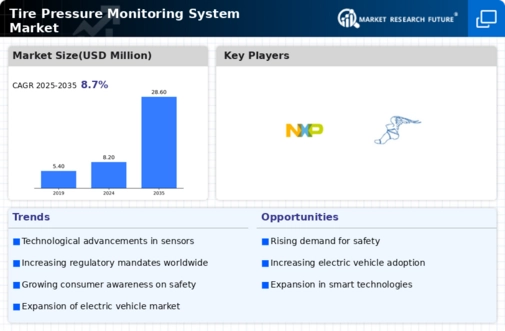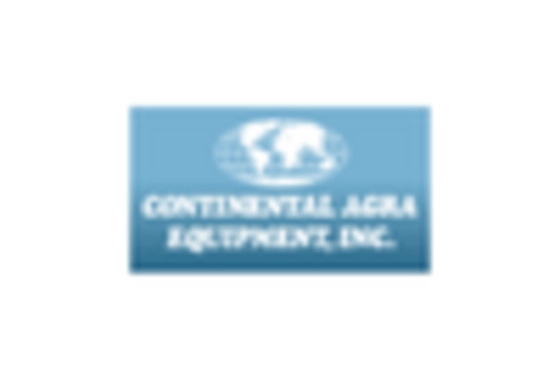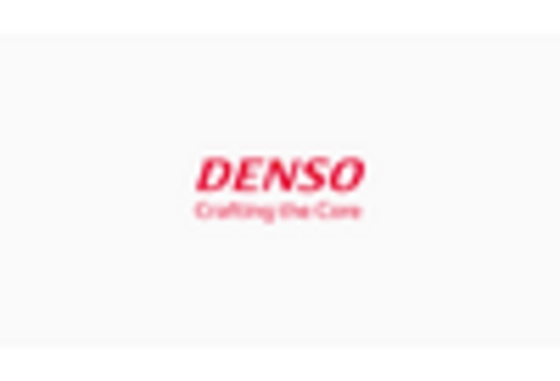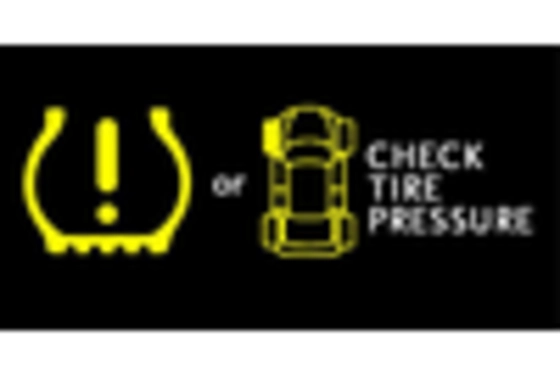-
EXECUTIVE SUMMARY 19
-
GLOBAL TIRE PRESSURE
-
MONITORING SYSTEM MARKET, BY TECHNOLOGY 21
-
GLOBAL TIRE PRESSURE MONITORING SYSTEM MARKET,
-
BY VEHICLE TYPE 22
-
1.3
-
GLOBAL TIRE PRESSURE MONITORING SYSTEM MARKET, BY SALES CHANNEL 23
-
MARKET INTRODUCTION 24
-
DEFINITION 24
-
SCOPE OF THE STUDY
-
24
-
RESEARCH
-
OBJECTIVE 24
-
2.4
-
MARKET STRUCTURE 25
-
3
-
RESEARCH METHODOLOGY 26
-
RESEARCH PROCESS 26
-
PRIMARY RESEARCH 27
-
SECONDARY RESEARCH 28
-
MARKET SIZE ESTIMATION 29
-
FORECAST MODEL 30
-
LIST OF ASSUMPTIONS 31
-
MARKET DYNAMICS 32
-
INTRODUCTION 32
-
DRIVERS 33
- RISING ADOPTION OF TIRE PRESSURE MONITORING
- GROWING DEMAND FOR THE SAFETY OF A VEHICLE 33
- DRIVER IMPACT ANALYSIS
-
SYSTEMS (TPMS) IN VEHICLES 33
-
34
-
RESTRAINT
- HIGH
- RESTRAINT IMPACT ANALYSIS 35
-
34
-
COST AND COMPLEXITY OF THE TPMS 34
-
OPPORTUNITY 35
- INCREASING SALES OF LUXURY CARS 35
-
COVID-19 IMPACT ON
- IMPACT ON THE GLOBAL TIRE PRESSURE MONITORING SYSTEM MARKET 36
- IMPACT ON MARKET DEMAND 37
- IMPACT
-
THE AUTOMOTIVE INDUSTRY 35
-
CHAIN ON THE GLOBAL TIRE PRESSURE MONITORING SYSTEM MARKET 36
-
RAW MATERIALS 36
-
4.5.1.2.1
-
CASH FLOW CONSTRAINTS 36
-
37
-
ON PRICING 37
-
5
-
MARKET FACTOR ANALYSIS 38
-
PORTER’S FIVE FORCES MODEL 38
- THREAT OF NEW ENTRANTS 39
- BARGAINING POWER OF SUPPLIERS
- THREAT
- INTENSITY OF RIVALRY 40
-
39
-
OF SUBSTITUTES 39
-
5.1.4
-
BARGAINING POWER OF BUYERS 39
-
SUPPLY CHAIN ANALYSIS 40
- DESIGN & DEVELOPMENT 41
- RAW MATERIAL/COMPONENT
-
SUPPLY 41
-
5.2.3
-
MANUFACTURE 41
-
5.2.4
-
DISTRIBUTION/SUPPLY 41
-
5.2.5
-
END USER 41
-
6
-
VEHICLE ANALYSIS 42
-
6.1
-
EV CHARGING PILES (DC, AC) 42
-
ADAS CALIBRATION 42
-
FOUR WHEEL ALLIGNMENT 43
-
BATTERY TEST 43
-
TIRE PATTERN DETECTION/MONITORING 43
-
COMMERCIAL VEHICLE
-
REGULATION MANAGEMENT 44
-
GLOBAL TIRE PRESSURE MONITORING SYSTEM MARKET, BY TECHNOLOGY 45
-
OVERVIEW 45
-
DIRECT TPMS 46
-
INDIRECT TPMS 46
-
GLOBAL TIRE PRESSURE
-
MONITORING SYSTEM, BY VEHICLE TYPE 47
-
OVERVIEW 47
-
PASSENGER CARS 48
-
LIGHT COMMERCIAL VEHICLE 48
-
HEAVY COMMERCIAL VEHICLE
-
48
-
GLOBAL
-
TIRE PRESSURE MONITORING SYSTEM, BY SALES CHANNEL 50
-
OVERVIEW 50
-
OEM 51
-
AFTERMARKET 51
-
GLOBAL TIRE PRESSURE MONITORING SYSTEM, BY REGION
-
52
-
OVERVIEW
- GLOBAL
-
52
-
TIRE PRESSURE MONITORING SYSTEM, BY REGION, 2018–2032 53
-
NORTH AMERICA 54
- NORTH AMERICA:
-
TIRE PRESSURE MONITORING SYSTEM MARKET, BY COUNTRY, 2018–2032 54
-
NORTH AMERICA:
-
TIRE PRESSURE MONITORING SYSTEM MARKET, BY TECHNOLOGY, 2018–2032 55
-
NORTH AMERICA:
-
TIRE PRESSURE MONITORING SYSTEM MARKET, BY VEHICLE TYPE, 2018–2032 55
-
NORTH AMERICA:
-
TIRE PRESSURE MONITORING SYSTEM MARKET, BY SALES CHANNEL, 2018–2032 55
-
US 56
-
US: TIRE PRESSURE
-
MONITORING SYSTEM MARKET, BY TECHNOLOGY, 2018–2032 56
-
BY VEHICLE TYPE, 2018–2032 56
-
SALES CHANNEL, 2018–2032 56
-
10.2.6.2
-
US: TIRE PRESSURE MONITORING SYSTEM MARKET,
-
US: TIRE PRESSURE MONITORING SYSTEM MARKET, BY
-
CANADA 57
-
CANADA: TIRE PRESSURE MONITORING SYSTEM MARKET, BY TECHNOLOGY,
-
CANADA: TIRE PRESSURE MONITORING SYSTEM MARKET, BY VEHICLE TYPE, 2018–2032
-
57
-
10.2.6.3
-
CANADA: TIRE PRESSURE MONITORING SYSTEM MARKET, BY SALES CHANNEL, 2018–2032
-
57
-
58
-
10.2.7.1
-
MEXICO
-
MEXICO: TIRE PRESSURE MONITORING SYSTEM MARKET, BY TECHNOLOGY, 2018–2032 58
-
MEXICO: TIRE
-
PRESSURE MONITORING SYSTEM MARKET, BY VEHICLE TYPE, 2018–2032 58
-
MEXICO: TIRE
-
PRESSURE MONITORING SYSTEM MARKET, BY SALES CHANNEL, 2018–2032 58
-
EUROPE 59
- EUROPE: TIRE PRESSURE
-
MONITORING SYSTEM MARKET, BY COUNTRY, 2018–2032 59
-
BY TECHNOLOGY, 2018–2032 60
-
10.3.4
-
EUROPE: TIRE PRESSURE MONITORING SYSTEM MARKET,
-
EUROPE: TIRE PRESSURE MONITORING SYSTEM MARKET, BY VEHICLE TYPE,
-
EUROPE: TIRE PRESSURE MONITORING SYSTEM MARKET, BY SALES CHANNEL, 2018–2032
-
60
-
61
-
10.3.5.1
-
UK
-
UK: TIRE PRESSURE MONITORING SYSTEM MARKET, BY TECHNOLOGY, 2018–2032 61
-
UK: TIRE PRESSURE
-
MONITORING SYSTEM MARKET, BY VEHICLE TYPE, 2018–2032 61
-
UK: TIRE PRESSURE MONITORING
-
SYSTEM MARKET, BY SALES CHANNEL, 2018–2032 61
-
GERMANY 62
-
GERMANY: TIRE PRESSURE MONITORING SYSTEM
-
MARKET, BY TECHNOLOGY, 2018–2032 62
-
GERMANY: TIRE PRESSURE MONITORING SYSTEM
-
MARKET, BY VEHICLE TYPE, 2018–2032 62
-
GERMANY: TIRE PRESSURE MONITORING SYSTEM
-
MARKET, BY SALES CHANNEL, 2018–2032 62
-
FRANCE 63
-
FRANCE: TIRE PRESSURE MONITORING SYSTEM
-
MARKET, BY TECHNOLOGY, 2018–2032 63
-
FRANCE: TIRE PRESSURE MONITORING SYSTEM
-
MARKET, BY VEHICLE TYPE, 2018–2032 63
-
FRANCE: TIRE PRESSURE MONITORING SYSTEM
-
MARKET, BY SALES CHANNEL, 2018–2032 63
-
BY TECHNOLOGY, 2018–2032 64
-
TYPE, 2018–2032 64
-
10.3.9
-
SPAIN 65
-
10.3.9.1
-
ITALY 64
-
ITALY: TIRE PRESSURE MONITORING SYSTEM MARKET,
-
ITALY: TIRE PRESSURE MONITORING SYSTEM MARKET, BY VEHICLE
-
ITALY: TIRE PRESSURE MONITORING SYSTEM MARKET, BY SALES CHANNEL,
-
SPAIN: TIRE PRESSURE MONITORING SYSTEM MARKET, BY TECHNOLOGY, 2018–2032 65
-
SPAIN: TIRE
-
PRESSURE MONITORING SYSTEM MARKET, BY VEHICLE TYPE, 2018–2032 65
-
SPAIN: TIRE
-
PRESSURE MONITORING SYSTEM MARKET, BY SALES CHANNEL, 2018–2032 65
-
66
-
10.3.10.1
-
REST OF EUROPE
-
REST OF EUROPE: TIRE PRESSURE MONITORING SYSTEM MARKET, BY TECHNOLOGY, 2018–2032
-
66
-
10.3.10.2
-
REST OF EUROPE: TIRE PRESSURE MONITORING SYSTEM MARKET, BY VEHICLE TYPE, 2018–2032
-
66
-
10.3.10.3
-
REST OF EUROPE: TIRE PRESSURE MONITORING SYSTEM MARKET, BY SALES CHANNEL, 2018–2032
-
66
-
ASIA-PACIFIC
- ASIA-PACIFIC:
-
67
-
TIRE PRESSURE MONITORING SYSTEM MARKET, BY COUNTRY, 2018–2032 68
-
ASIA-PACIFIC:
-
TIRE PRESSURE MONITORING SYSTEM MARKET, BY TECHNOLOGY, 2018–2032 68
-
ASIA-PACIFIC:
-
TIRE PRESSURE MONITORING SYSTEM MARKET, BY VEHICLE TYPE, 2018–2032 68
-
ASIA-PACIFIC:
-
TIRE PRESSURE MONITORING SYSTEM MARKET, BY SALES CHANNEL, 2018–2032 69
-
CHINA 69
-
CHINA: TIRE
-
PRESSURE MONITORING SYSTEM MARKET, BY TECHNOLOGY, 2018–2032 69
-
CHINA: TIRE PRESSURE
-
MONITORING SYSTEM MARKET, BY VEHICLE TYPE, 2018–2032 69
-
CHINA: TIRE PRESSURE
-
MONITORING SYSTEM MARKET, BY SALES CHANNEL, 2018–2032 70
-
INDIA 70
-
INDIA: TIRE PRESSURE
-
MONITORING SYSTEM MARKET, BY TECHNOLOGY, 2018–2032 70
-
BY VEHICLE TYPE, 2018–2032 70
-
BY SALES CHANNEL, 2018–2032 71
-
BY TECHNOLOGY, 2018–2032 71
-
TYPE, 2018–2032 71
-
10.4.8
-
SOUTH KOREA 72
-
10.4.8.1
-
INDIA: TIRE PRESSURE MONITORING SYSTEM MARKET,
-
INDIA: TIRE PRESSURE MONITORING SYSTEM MARKET,
-
JAPAN 71
-
JAPAN: TIRE PRESSURE MONITORING SYSTEM MARKET,
-
JAPAN: TIRE PRESSURE MONITORING SYSTEM MARKET, BY VEHICLE
-
JAPAN: TIRE PRESSURE MONITORING SYSTEM MARKET, BY SALES CHANNEL,
-
SOUTH KOREA: TIRE PRESSURE MONITORING SYSTEM MARKET, BY TECHNOLOGY, 2018–2032
-
72
-
10.4.8.2
-
SOUTH KOREA: TIRE PRESSURE MONITORING SYSTEM MARKET, BY VEHICLE TYPE, 2018–2032
-
72
-
10.4.8.3
-
SOUTH KOREA: TIRE PRESSURE MONITORING SYSTEM MARKET, BY SALES CHANNEL, 2018–2032
-
73
-
OF ASIA-PACIFIC 73
-
10.4.9.1
-
REST
-
REST OF ASIA-PACIFIC: TIRE PRESSURE MONITORING SYSTEM MARKET, BY TECHNOLOGY, 2018–2032
-
73
-
10.4.9.2
-
REST OF ASIA-PACIFIC: TIRE PRESSURE MONITORING SYSTEM MARKET, BY VEHICLE TYPE, 2018–2032
-
73
-
10.4.9.3
-
REST OF ASIA-PACIFIC: TIRE PRESSURE MONITORING SYSTEM MARKET, BY SALES CHANNEL,
-
10.5
-
MIDDLE EAST & AFRICA 75
-
BY COUNTRY, 2018–2032 75
-
BY TECHNOLOGY, 2018–2032 76
-
BY VEHICLE TYPE, 2018–2032 76
-
MIDDLE EAST & AFRICA: TIRE PRESSURE MONITORING SYSTEM MARKET,
-
MIDDLE EAST & AFRICA: TIRE PRESSURE MONITORING SYSTEM MARKET,
-
MIDDLE EAST & AFRICA: TIRE PRESSURE MONITORING SYSTEM MARKET,
-
MIDDLE EAST & AFRICA: TIRE PRESSURE MONITORING
-
SYSTEM MARKET, BY SALES CHANNEL, 2018–2032 76
-
BY TECHNOLOGY, 2018–2032 77
-
10.5.5.3
-
UAE 77
-
UAE: TIRE PRESSURE MONITORING SYSTEM MARKET,
-
UAE: TIRE PRESSURE MONITORING SYSTEM MARKET, BY VEHICLE TYPE,
-
UAE: TIRE PRESSURE MONITORING SYSTEM MARKET, BY SALES CHANNEL, 2018–2032 77
-
SAUDI ARABIA 78
-
SAUDI ARABIA:
-
TIRE PRESSURE MONITORING SYSTEM MARKET, BY TECHNOLOGY, 2018–2032 78
-
SAUDI ARABIA:
-
TIRE PRESSURE MONITORING SYSTEM MARKET, BY VEHICLE TYPE, 2018–2032 78
-
SAUDI ARABIA:
-
TIRE PRESSURE MONITORING SYSTEM MARKET, BY SALES CHANNEL, 2018–2032 78
-
SOUTH AFRICA 79
-
SOUTH AFRICA:
-
TIRE PRESSURE MONITORING SYSTEM MARKET, BY TECHNOLOGY, 2018–2032 79
-
SOUTH AFRICA:
-
TIRE PRESSURE MONITORING SYSTEM MARKET, BY VEHICLE TYPE, 2018–2032 79
-
SOUTH AFRICA:
-
TIRE PRESSURE MONITORING SYSTEM MARKET, BY SALES CHANNEL, 2018–2032 79
-
REST OF MEA 80
-
REST OF MEA:
-
TIRE PRESSURE MONITORING SYSTEM MARKET, BY TECHNOLOGY, 2018–2032 80
-
REST OF MEA:
-
TIRE PRESSURE MONITORING SYSTEM MARKET, BY VEHICLE TYPE, 2018–2032 80
-
REST OF MEA:
-
TIRE PRESSURE MONITORING SYSTEM MARKET, BY SALES CHANNEL, 2018–2032 80
-
SOUTH AMERICA 81
- SOUTH AMERICA:
-
TIRE PRESSURE MONITORING SYSTEM MARKET, BY COUNTRY, 2018–2032 81
-
SOUTH AMERICA:
-
TIRE PRESSURE MONITORING SYSTEM MARKET, BY TECHNOLOGY, 2018–2032 82
-
SOUTH AMERICA:
-
TIRE PRESSURE MONITORING SYSTEM MARKET, BY VEHICLE TYPE, 2018–2032 82
-
SOUTH AMERICA:
-
TIRE PRESSURE MONITORING SYSTEM MARKET, BY SALES CHANNEL, 2018–2032 82
-
BRAZIL 83
-
BRAZIL: TIRE
-
PRESSURE MONITORING SYSTEM MARKET, BY TECHNOLOGY, 2018–2032 83
-
BRAZIL: TIRE PRESSURE
-
MONITORING SYSTEM MARKET, BY VEHICLE TYPE, 2018–2032 83
-
BRAZIL: TIRE PRESSURE
-
MONITORING SYSTEM MARKET, BY SALES CHANNEL, 2018–2032 83
-
ARGENTINA 84
-
ARGENTINA: TIRE
-
PRESSURE MONITORING SYSTEM MARKET, BY TECHNOLOGY, 2018–2032 84
-
ARGENTINA: TIRE PRESSURE
-
MONITORING SYSTEM MARKET, BY VEHICLE TYPE, 2018–2032 84
-
ARGENTINA: TIRE PRESSURE
-
MONITORING SYSTEM MARKET, BY SALES CHANNEL, 2018–2032 84
-
85
-
10.6.7.1
-
REST OF SOUTH AMERICA
-
REST OF SOUTH AMERICA: TIRE PRESSURE MONITORING SYSTEM MARKET, BY TECHNOLOGY, 2018–2032
-
85
-
10.6.7.2
-
REST OF SOUTH AMERICA: TIRE PRESSURE MONITORING SYSTEM MARKET, BY VEHICLE TYPE,
-
10.6.7.3
-
REST OF SOUTH AMERICA: TIRE PRESSURE MONITORING SYSTEM MARKET, BY SALES CHANNEL,
-
11
-
COMPETITIVE LANDSCAPE 86
-
COMPETITIVE OVERVIEW 86
-
COMPETITIVE DASHBOARD 87
-
MARKET SHARE ANALYSIS 88
-
KEY DEVELOPMENTS IN THE GLOBAL TIRE PRESSURE
- KEY DEVELOPMENTS: CONTRACTS & AGREEMENTS 88
- KEY DEVELOPMENTS: PARTNERSHIPS
- KEY DEVELOPMENTS: PRODUCT DEVELOPMENTS/LAUNCHES 89
-
MONITORING SYSTEM MARKET 88
-
& COLLABORATIONS 89
-
COMPETITION BENCHMARKING
-
91
-
COMPANY
-
PROFILE 92
-
12.1
-
NXP SEMICONDUCTORS 92
-
12.1.1
-
COMPANY OVERVIEW 92
-
12.1.2
-
FINANCIAL OVERVIEW 93
-
12.1.3
-
PRODUCTS OFFERED 93
-
12.1.4
-
KEY DEVELOPMENTS 94
-
12.1.5
-
SWOT ANALYSIS 94
-
12.1.6
-
KEY STRATEGIES 94
-
12.2
-
THE GOODYEAR TIRE & RUBBER COMPANY 95
-
101
-
12.3.3
-
PRODUCTS OFFERED 101
-
12.3.4
-
KEY DEVELOPMENTS 102
-
12.3.5
-
SWOT ANALYSIS 102
-
12.3.6
-
KEY STRATEGIES 102
-
12.4
-
SHANGHAI BAOLONG AUTOMOTIVE CORPORATION 103
-
107
-
12.5.5
-
SWOT ANALYSIS 107
-
12.5.6
-
KEY STRATEGIES 107
-
12.6
-
CUB ELECPARTS INC 108
-
12.6.1
-
COMPANY OVERVIEW 108
-
12.6.2
-
FINANCIAL OVERVIEW 109
-
12.6.3
-
PRODUCTS/SERVICES/SOLUTIONS OFFERED 109
-
111
-
12.7.2
-
FINANCIAL OVERVIEW 111
-
12.7.3
-
PRODUCTS/SERVICES/SOLUTIONS OFFERED 112
-
115
-
12.8.3
-
PRODUCTS/SERVICES/SOLUTIONS OFFERED 116
-
LTD) 118
-
12.9.1
-
COMPANY OVERVIEW 118
-
12.9.2
-
FINANCIAL OVERVIEW 118
-
12.9.3
-
PRODUCTS/SERVICES/SOLUTIONS OFFERED 119
-
AG) 121
-
12.10.1
-
COMPANY OVERVIEW 121
-
12.10.2
-
FINANCIAL OVERVIEW 122
-
12.10.3
-
PRODUCTS/SERVICES/SOLUTIONS OFFERED 122
-
125
-
12.11.5
-
SWOT ANALYSIS 126
-
12.11.6
-
KEY STRATEGIES 126
-
12.12
-
VALEO 127
-
12.12.1
-
COMPANY OVERVIEW 127
-
12.12.2
-
FINANCIAL OVERVIEW 128
-
12.12.3
-
PRODUCTS OFFERED 128
-
-
COMPANY OVERVIEW 95
-
FINANCIAL OVERVIEW 96
-
PRODUCTS OFFERED 97
-
KEY DEVELOPMENTS 97
-
SWOT ANALYSIS 99
-
KEY STRATEGIES 99
-
ZF FRIEDRICHSHAFEN AG 100
- COMPANY OVERVIEW 100
- FINANCIAL OVERVIEW
- COMPANY OVERVIEW 103
- FINANCIAL OVERVIEW 104
- PRODUCTS OFFERED 104
- KEY DEVELOPMENTS 105
- SWOT ANALYSIS 105
- KEY STRATEGIES 105
-
BH SENS GROUP 106
- COMPANY OVERVIEW 106
- FINANCIAL OVERVIEW 106
- PRODUCTS/SERVICES/SOLUTIONS OFFERED 106
- KEY DEVELOPMENTS
- KEY DEVELOPMENTS 110
- SWOT ANALYSIS 110
- KEY STRATEGIES 110
-
INTELLIGENT TECHNOLOGY CORP, LTD. (AUTEL) 111
- COMPANY OVERVIEW
- KEY DEVELOPMENTS 113
- SWOT ANALYSIS 113
- KEY STRATEGIES 114
-
INFINEON TECHNOLOGIES AG 115
- COMPANY OVERVIEW 115
- FINANCIAL OVERVIEW
- KEY DEVELOPMENTS 116
- SWOT ANALYSIS 117
- KEY STRATEGIES 117
-
HAMATON LTD (HAMATON AUTOMOTIVE TECHNOLOGY CO.
- KEY DEVELOPMENTS 119
- SWOT ANALYSIS 120
- KEY STRATEGIES 120
-
BENDIX COMMERCIAL VEHICLE SYSTEMS LLC (KNORR-BREMSE
- KEY DEVELOPMENTS 123
- SWOT ANALYSIS 124
- KEY STRATEGIES 124
-
VALOR EUROPE GMBH 125
- COMPANY OVERVIEW 125
- FINANCIAL OVERVIEW 125
- PRODUCTS OFFERED 125
- KEY DEVELOPMENTS









Leave a Comment